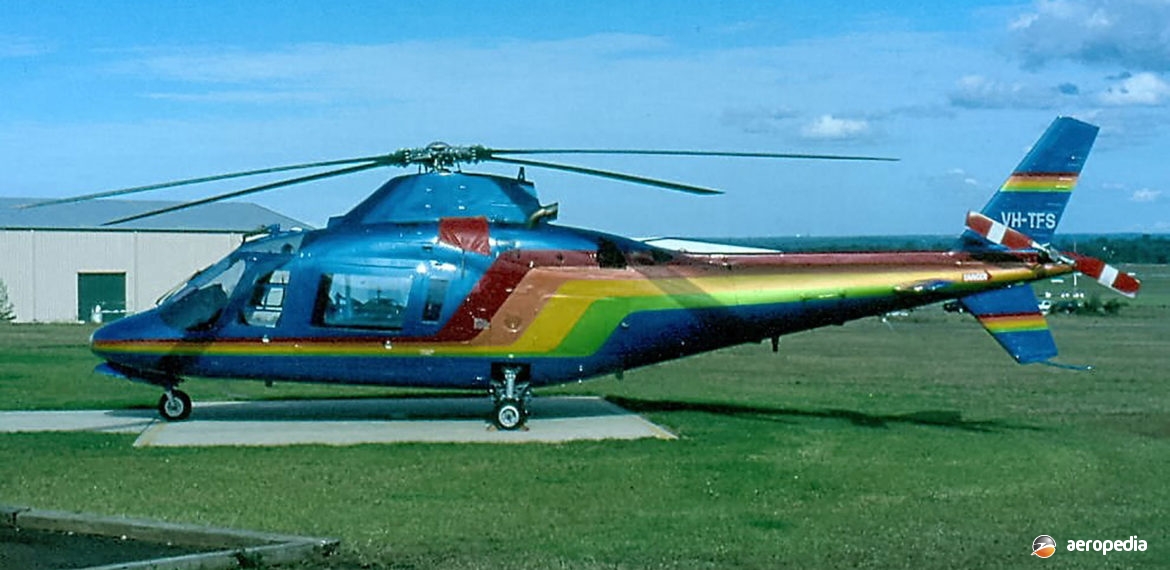Photograph:
Agusta A-109A II VH-TFS (c/n 7348) at Bankstown, NSW in May 1995 (David C Eyre)
Country of origin:
Italy
Description:
Light utility helicopter
Power Plant:
Two 313 kw (420 shp) Allison 250-C20B turboshafts
Specifications:
- Rotor diameter: 11 m (26 ft 1 in)
- Length overall: 13.03 m (42 ft 9 in)
- Height: 3.32 m (10 ft 10 ¾ in)
- Max speed: 311 km/h (193 mph)
- Max cruising speed: 278 km/h (173 mph)
- Economical cruising speed at sea level: 231 km/h (143 mph)
- Max rate of climb at sea level: 493 m/min (1,620 ft/min)
- Service ceiling: 4,968 m (16,300 ft)
- Max range at sea level: 573 km (356 miles)
- Empty weight: 1,418 kg (3,125 lb)
- Loaded weight: 2,600 kg (5,730 lb)
History:
The A-109 series of helicopters was designed by Costruzioni Aeronautiche Giovanni Agusta SpA in Italy as a high-speed, high-performance, twin-engine helicopter, the basic commercial model accommodating a pilot and seven passengers. Alternatively, it could be used for all-cargo carrying, as an ambulance, and for search-and-rescue work,. I later years it was produced in special versions for military use. Three prototypes were built for development trials, the first of these, known as the A-109, making its initial flight on 4 August 1971.
After certification, the type entered production as the A-109A, deliveries commencing in 1976. The A-109A was fitted with the well-tried Allison 250 turboshaft engine, and had a retractable undercarriage. Normal accommodation was for a crew of two with six passengers in two rows of three. However, a seventh passenger could be carried in lieu of the second crew member. A large baggage area was situated behind the rear row of passenger seats.
Subsequently a refined version, known as the A-109A Mk II, appeared, and the first of four prototypes was flown on 4 August 1971. This model was considerably improved as production proceeded, including an increase of the transmission rating of the combined engines from 516 kw (692 shp) to 552 kw (740 shp), and the maximum continuous rating of each engine from 287 kw (385 shp) to 313 kw (420 shp).
The first of this series in this region, an A-109A Mk II, arrived in August 1983 for Mount Isa Mines and became VH-MQB (c/n 7282). It was followed by VH-DMR (c/n 7328) for the NSW Department of Main Roads.
First of the type in New Zealand was an A-109A-2 ZK-HXI (c/7378 – ex N109BL, N109TA) in August 1987 which was later exported to Australia as VH-AUG.
The type has been developed over the years. In 1981 the A-109A was superceded by the A-109A Mk II which incorporated a greater transmission rating, a re-designed tail boom, a new tail rotor drive shaft, improved rotor blade life, and upgraded avionics. This was followed by the Mk II Plus with Allison 250C20R-1 engines; and the A-109C with composite rotor blades.
The A-109K appeared in April 1983 with two 477 kw (640 shp) Turbomeca Arriel 1K1 turboshafts. The A-109E Power which first flew on 8 February 1995 was based on the A-109K2, had a strengthened undercarriage, an improved main rotor, and Pratt & Whitney PW206C engines of 477 kw (640 shp).
In late 2006 the Royal Australian Navy selected the A-109E Power as an interim training helicopter, these machines to be leased from Raytheon Australia and attached to No 723 Squadron to replace the SH-2G(A) Seasprite in this role pending finalisation of problems in the introduction of the latter to service. The first two machines became N42-501 and N42-510. Another A-109E Power was leased by the Australian Defence Force from Becker Helicopters to train Australian Army Eurocopter Tiger pilots.
In late 2007 the New Zealand Government announced an order had been placed for five Agusta-Westland LUH (light utility helicopter) helicopter variants of the A-109 series for service with the RNZAF to be used by that service and to replace the Bell 47 Sioux series. As well as being used in the training role, these machines would be used for search-and-rescue, air transport, medical evacuation, disaster response, surveillance and counter-terrorism work, delivery to take place in 2010.
The first three aircraft were taken on charge by the RNZAF in a handing over ceremony on 13 May 2011, the fourth in June, and the fifth in September, with an additional airframe being obtained and stripped down for spares. These machines were fitted with two 453 kw (607 shp) Turbomeca Arrius 2KZ turboshafts and had the ability to carry an SC-17 searchline and a 7.62 mm (0.3 in) MAG058 machine gun mounted at the port cabin door. The five machines were: NZ3401 (c/n 13781), NZ3402 (c/n 13782), NZ3403 (c/n 13784), NZ3404 (c/n 13785), NZ3405 (c/n 13786) and spares airframe NZ3406 (c/n 13783).
In late October 2011 the A-109 completed integration trials with the RNZ Navy multi-role vessel the HMNZS Canterbury. These trials were to test the helicopters on the ship in non-operational conditions, and their ability to operate and be maintained on the ships of the Navy. The ship was the Navy’s sealift and amphibious support vessel and could transport a blend of A-109 or Kaman Seasprite helicopters in support of air and land operations and disaster relief. Later it transported the NH Industries NH-90 helicopter.

